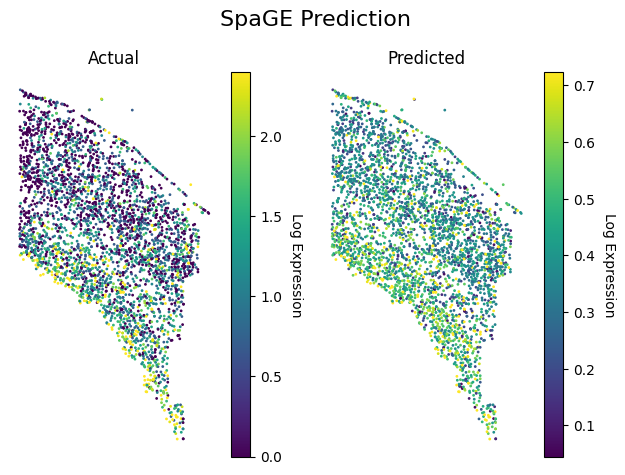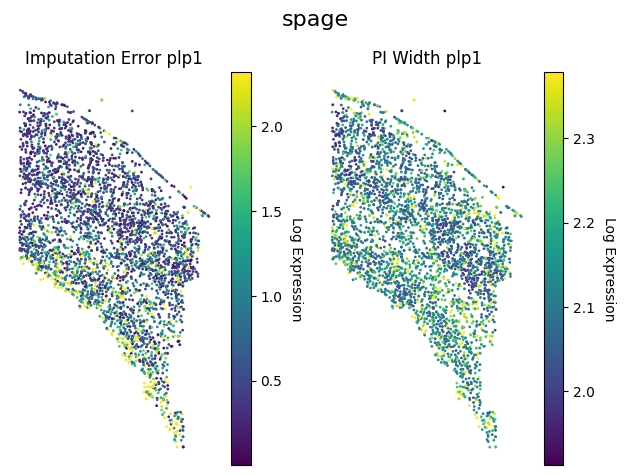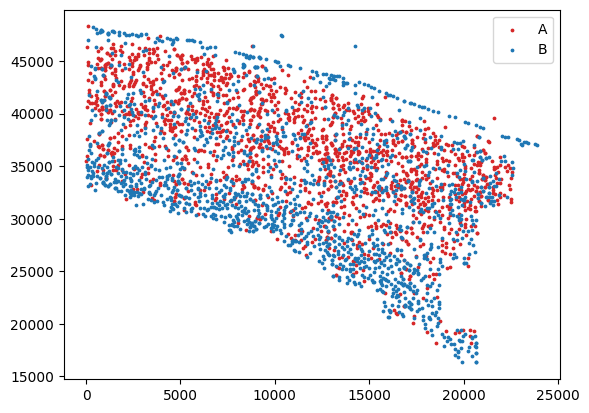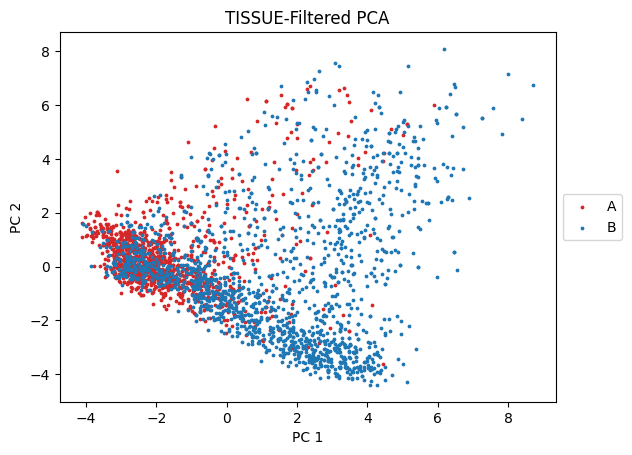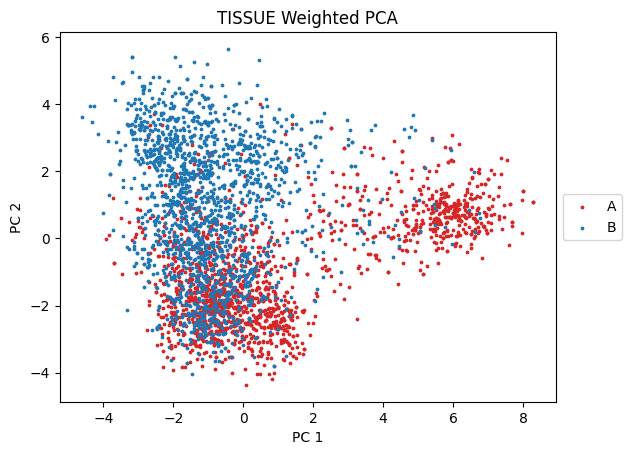TISSUE (Transcript Imputation with Spatial Single-cell Uncertainty Estimation) provides tools for estimating well-calibrated uncertainty measures for gene expression predictions in single-cell spatial transcriptomics datasets and utilizing them in downstream analyses
If you find TISSUE useful, please consider citing our publication:
Sun, E.D., Ma, R., Navarro Negredo, P. et al. TISSUE: uncertainty-calibrated prediction of single-cell spatial transcriptomics improves downstream analyses. Nat Methods (2024). https://doi.org/10.1038/s41592-024-02184-y
Complete installation (including of dependencies) of TISSUE in a new Conda environment should take less than 5 minutes on a normal desktop/laptop setup (Windows, Mac OSX, Linux). The base version of TISSUE requires SquidPy and all of its dependencies. The base version comes with the SpaGE spatial gene expression prediction method. Additional TISSUE functionalities (i.e. Tangram prediction, Harmony-kNN prediction, gimVI prediction, TISSUE-WPCA, TISSUE multiple imputation with SpatialDE) require installing additional dependencies, which are listed in requirements.txt. These should be installed with pip install <package name>==<package version> inside the same Conda environment as TISSUE (preferably before TISSUE installation).
For TISSUE installation, we provide two options: (A) PyPI installation with pip or (B) local installation. We recommend starting with option A and only going to option B if option A fails in your environment.
Install the package through PyPI with pip. We recommend setting up a conda environment (https://docs.conda.io/projects/conda/en/latest/user-guide/tasks/manage-environments.html) or another virtual environment first since tissue-sc currently relies on specific versions for its dependencies (although it should generally work for other environment versions, but this hasn't been thoroughly tested):
conda create -n myenv python=3.8
conda activate myenv
<pip install any additional dependencies>
pip install tissue-sc
Note that you will want to separately download the data from this repository (tests/data/) to run our TISSUE tutorials.
An alternative way to install the package along with associated test and tutorial files is to clone the directory and then install the requirements for using the package. To do this, first clone the repository using git (you can install git following the instructions here):
git clone https://github.com/sunericd/TISSUE.git
We recommend setting up a conda environment to install the requirements for the package (instructions for installing conda and what conda environment can do can be found here). Installation of requirements can then be done with the following commands:
conda create -n tissue python=3.8
conda activate tissue
cd TISSUE
pip install -r requirements.txt
To keep the requirements light, we have only included packages that are necessary for the core functionalities of TISSUE. For additional utilities such as gene prediction with Tangram, please install those packages separately (or uncomment those lines in requirements.txt).
To test that the installation is working correctly, you can run python test.py in the cloned directory.
Below we include several mini-tutorials to highlight the main TISSUE pipeline and downstream applications. These tutorials rely on a small test dataset (a subset of one of the datasets used in the original publication) for fast processing but the approaches can readily be extended to other datasets. For larger-scale examples, please refer to the code repository corresponding the figures and analyses generated for the TISSUE manuscript: https://github.com/sunericd/tissue-figures-and-analyses.git
# import packages
import tissue.main, tissue.downstream
import numpy as np
import pandas as pd
import matplotlib.pyplot as plt
import scanpy as sc
import anndata as ad
import osThe first part of the TISSUE pipeline involves making predictions of spatial gene expression profiles using paired spatial transcriptomics and scRNAseq datasets, and then computing and calibrating uncertainties for these predictions that are translated to prediction intervals. All functions for upstream analysis are in the tissue.main module. These include:
-
tissue.main.load_paired_datasets()for loading paired datasets from formatted directories -
tissue.main.predict_gene_expression()for predicting spatial gene expression from paired datasets using a specified prediction method and number of cross-validation folds -
tissue.main.build_spatial_graph()for building a cell-cell spatial graph to define neighborhoods for computing the cell-centric variability -
tissue.main.conformalize_spatial_uncertainty()for computing cell-centric variability, stratified grouping, and the TISSUE calibration scores for predicted gene expression -
tissue.main.conformalize_prediction_interval()for building prediction intervals from uncertainty measures
First, we load a minimal subset of osmFISH spatial transcriptomics data of mouse somatosensory cortex published by Codeluppi et al., 2018: https://doi.org/10.1038/s41592-018-0175-z.
Note that we are using the TISSUE methods for building an AnnData object from tab-delimited text files for the spatial counts, scRNAseq counts, spatial locations, and spatial metadata. If you already have an AnnData object for the spatial data and another object for the scRNAseq data, you can skip this step.
# load in spatial and scRNAseq datasets
adata, RNAseq_adata = tissue.main.load_paired_datasets("tests/data/Spatial_count.txt",
"tests/data/Locations.txt",
"tests/data/scRNA_count.txt")/home/edsun/anaconda3/envs/tissue/lib/python3.8/site-packages/anndata/_core/anndata.py:117: ImplicitModificationWarning: Transforming to str index.
warnings.warn("Transforming to str index.", ImplicitModificationWarning)
/home/edsun/anaconda3/envs/tissue/lib/python3.8/site-packages/anndata/_core/anndata.py:856: UserWarning:
AnnData expects .obs.index to contain strings, but got values like:
[0, 1, 2, 3, 4]
Inferred to be: integer
names = self._prep_dim_index(names, "obs")
Now we can impute any genes of interest that are found in the scRNAseq dataset but not in the spatial dataset. In this case, we will hold out a target gene from the spatial data and apply an imputation method to predict its expression using the scRNAseq dataset.
First, we preprocess the data and make sure that the gene names are matchable across the two datasets:
# make genes lowercase
adata.var_names = [x.lower() for x in adata.var_names]
RNAseq_adata.var_names = [x.lower() for x in RNAseq_adata.var_names]
# preprocess RNAseq data
tissue.main.preprocess_data(RNAseq_adata, standardize=False, normalize=True)
# subset spatial data into shared genes
gene_names = np.intersect1d(adata.var_names, RNAseq_adata.var_names)
adata = adata[:, gene_names].copy()
# hold out target gene
target_gene = "plp1"
target_expn = adata[:, target_gene].X.copy()
adata = adata[:, [gene for gene in gene_names if gene != target_gene]].copy()# dimensions of spatial transcriptomics dataset (number of cells x number of genes)
adata.shape(3405, 31)
# dimensions of RNAseq dataset (number of cells x number of genes)
RNAseq_adata.shape(1000, 32)
Now, we can make predictions of the target gene expression. In TISSUE, we currently have several methods for gene imputation including SpaGE, Tangram, and Harmony-kNN. We will be using SpaGE in this example:
# SpaGE spatial gene expression prediction
tissue.main.predict_gene_expression (adata, RNAseq_adata, [target_gene],
method="spage", n_folds=10, n_pv=10)How good is the imputation? Since we left out this gene from the spatial data, we can plot the predicted and actual expression and visually inspect the agreement.
# Visualizing predicted and actual expression side by side
fig, (ax1, ax2) = plt.subplots(1, 2)
ax1.axis('off')
cmap = target_expn
cmap[cmap<0] = 0
cmap = np.log1p(cmap)
cmap[cmap > np.percentile(cmap,95)] = np.percentile(cmap,95)
im = ax1.scatter(adata.obsm['spatial'][:,0],adata.obsm['spatial'][:,1],s=1,c=cmap,rasterized=True)
ax1.set_title('Actual', fontsize = 12)
cbar = fig.colorbar(im)
cbar.ax.get_yaxis().labelpad = 15
cbar.ax.set_ylabel('Log Expression', rotation=270)
ax2.axis('off')
cmap = adata.obsm['spage_predicted_expression'][target_gene].values
cmap[cmap<0] = 0
cmap = np.log1p(cmap)
cmap[cmap > np.percentile(cmap,95)] = np.percentile(cmap,95)
im = ax2.scatter(adata.obsm['spatial'][:,0],adata.obsm['spatial'][:,1],s=1,c=cmap,rasterized=True)
ax2.set_title('Predicted', fontsize = 12)
cbar = fig.colorbar(im)
cbar.ax.get_yaxis().labelpad = 15
cbar.ax.set_ylabel('Log Expression', rotation=270)
plt.suptitle("SpaGE Prediction", fontsize=16)
plt.tight_layout()
plt.show()Not too bad, especially considering that we used a downsampled scRNAseq dataset for this imputation.
Note that when we ran tissue.main.predict_gene_expression() in the previous tutorial, we obtained cross-validated predictions for all genes in the existing spatial dataset (e.g. 10 folds). These will now come in handy when we compute and calibrate TISSUE uncertainties for the predicted gene expression.
First, we build spatial graphs using TISSUE (this can also be done with native Scanpy functions):
# build spatial graph and calculate adjacency weights
tissue.main.build_spatial_graph(adata, method="fixed_radius", n_neighbors=15)The entire TISSUE spatial uncertainty generation pipeline can be launched with one line of code using tissue.main.conformalize_spatial_uncertainty(). Here, the first two arguments are the spatial AnnData object and a string specifier for the key in obsm corresponding to the predicted gene expression. We can specify which of the genes to use in the calibration set (generally this is all genes in the spatial data). There are other arguments for the grouping setup and weighting schemes, but we will use the default settings in this tutorial.
# build calibration scores
tissue.main.conformalize_spatial_uncertainty(adata, "spage_predicted_expression", calib_genes=adata.var_names,
grouping_method="kmeans_gene_cell", k=4, k2=2)/home/edsun/anaconda3/envs/tissue/lib/python3.8/site-packages/sklearn/cluster/_kmeans.py:870: FutureWarning: The default value of `n_init` will change from 10 to 'auto' in 1.4. Set the value of `n_init` explicitly to suppress the warning
warnings.warn(
/home/edsun/anaconda3/envs/tissue/lib/python3.8/site-packages/sklearn/cluster/_kmeans.py:870: FutureWarning: The default value of `n_init` will change from 10 to 'auto' in 1.4. Set the value of `n_init` explicitly to suppress the warning
warnings.warn(
/home/edsun/anaconda3/envs/tissue/lib/python3.8/site-packages/sklearn/cluster/_kmeans.py:870: FutureWarning: The default value of `n_init` will change from 10 to 'auto' in 1.4. Set the value of `n_init` explicitly to suppress the warning
warnings.warn(
/home/edsun/anaconda3/envs/tissue/lib/python3.8/site-packages/sklearn/cluster/_kmeans.py:870: FutureWarning: The default value of `n_init` will change from 10 to 'auto' in 1.4. Set the value of `n_init` explicitly to suppress the warning
warnings.warn(
/home/edsun/anaconda3/envs/tissue/lib/python3.8/site-packages/sklearn/cluster/_kmeans.py:870: FutureWarning: The default value of `n_init` will change from 10 to 'auto' in 1.4. Set the value of `n_init` explicitly to suppress the warning
warnings.warn(
Finally, we can calibrate the spatial uncertainty measures to get calibration scores and then use those to extract prediction intervals for any confidence level tissue.main.conformalize_prediction_interval()
# get prediction interval for 67% coverage
tissue.main.conformalize_prediction_interval (adata, "spage_predicted_expression", calib_genes=adata.var_names,
alpha_level=0.23)
# set `compute_wasserstein=True` to compute a measure indicating the distance between the cell-centric variability values
# of the predicted genes and the values of their support (i.e. calibration group) in the original data.
# The lower this value, the better supported the predicted group.Now let's visualize what these prediction intervals look like for the target (unseen) gene and how it compares to the actual prediction errors.
m = "spage"
i = np.where(adata.var_names == target_gene)[0]
# define consistent color map
all_vals = np.concatenate((np.abs(target_expn.flatten()-adata.obsm[m+"_predicted_expression"][target_gene].values),
adata.obsm[m+f"_predicted_expression_hi"][target_gene].values-adata.obsm[m+f"_predicted_expression_lo"][target_gene].values))
all_vals[all_vals<0]=0
vmin = np.percentile(np.log1p(all_vals), 0)
vmax = np.percentile(np.log1p(all_vals), 95)
fig, (ax1, ax2) = plt.subplots(1, 2)
ax1.axis('off')
cmap = np.abs(target_expn.flatten()-adata.obsm[m+"_predicted_expression"][target_gene].values)
cmap[cmap<0] = 0
cmap = np.log1p(cmap)
cmap[cmap > np.percentile(cmap,95)] = np.percentile(cmap,95)
im = ax1.scatter(adata.obsm['spatial'][:,0],adata.obsm['spatial'][:,1],s=1,c=cmap,rasterized=True)#,vmin=vmin,vmax=vmax)
ax1.set_title('Imputation Error ' + target_gene, fontsize = 12)
cbar = fig.colorbar(im)
cbar.ax.get_yaxis().labelpad = 15
cbar.ax.set_ylabel('Log Expression', rotation=270)
ax2.axis('off')
cmap = adata.obsm[m+f"_predicted_expression_hi"][target_gene].values-adata.obsm[m+f"_predicted_expression_lo"][target_gene].values
cmap[cmap<0] = 0
cmap = np.log1p(cmap)
cmap[cmap > np.percentile(cmap,95)] = np.percentile(cmap,95)
im = ax2.scatter(adata.obsm['spatial'][:,0],adata.obsm['spatial'][:,1],s=1,c=cmap,rasterized=True)#,vmin=vmin,vmax=vmax)
ax2.set_title('PI Width ' + target_gene, fontsize = 12)
cbar = fig.colorbar(im)
cbar.ax.get_yaxis().labelpad = 15
cbar.ax.set_ylabel('Log Expression', rotation=270)
plt.suptitle(m, fontsize=16)
plt.tight_layout()
plt.show()The TISSUE prediction intervals are decent and match the distribution of imputation errors especially well in the bottom portions of the section. On the full dataset, which has much richer reference scRNAseq data, the calibration quality is further improved (see Figure 2 of the TISSUE manuscript).
TISSUE provides additional functionalities for leveraging these uncertainty estimates and prediction intervals in common downstream single-cell spatial transcriptomics analysese. All functions for downstream analysis are in the tissue.downstream module. These include:
-
tissue.downstream.multiple_imputation_testing()for hypothesis testing using multiple imputations drawn from the calibration score sets -
tissue.downstream.weighted_PCA()for computing weighted principal components where weights correspond to a transform of the inverse prediction interval width -
tissue.downstream.detect_uncertain_cells()for filtering low-confidence cells from data before training and evaluation of machine learning models, which generally improves performance
Below we include a few example uses of these modules. For more examples (including those for the experiments in the associated manuscript), please see the Github repository: https://github.com/sunericd/tissue-figures-and-analyses.git.
This tutorial uses the TISSUE calibration scores to generate multiple imputations and then perform hypothesis testing by aggregating statistics across these multiple imputations. The default and recommended statistical test for this framework is the Student's t-test, but other options for spatially variable gene detection using SpatialDE and non-parametric (one-sided) Mann-Whitney/Wilcoxon tests can also be performed by specifying method="spatialde", method="wilcoxon_greater", method="wilcoxon_less" for tissue.downstream.multiple_imputation_testing().
Please run the code in Tutorials 1-2 to generate predictions and TISSUE uncertainty measures before this tutorial.
After, we construct some binary labels for the cells in the dataset:
# split into two groups based on indices
adata.obs['condition'] = ['A' if i < round(adata.shape[0]/2) else 'B' for i in range(adata.shape[0])]
# plot conditions
plt.scatter(adata[adata.obs.condition=="A"].obsm['spatial'][:,0],
adata[adata.obs.condition=="A"].obsm['spatial'][:,1],
c='tab:red', s=3, label="A")
plt.scatter(adata[adata.obs.condition=="B"].obsm['spatial'][:,0],
adata[adata.obs.condition=="B"].obsm['spatial'][:,1],
c='tab:blue', s=3, label="B")
plt.legend(loc='best')
plt.show()As we can see, the cells in group A primarily belong to the medial layers of the section while the cells in group B correspond to upper pia layer and also the bottom layers of the section. As such, when we do differential gene expression analysis, we should expect some differentially expressed markers between these two labels.
Now, we perform differential gene expression analysis using TISSUE multiple imputation hypothesis testing, which works by using TISSUE calibration scores to sample multiple "imputations" (alternative predictions) and then aggregate these statistics together afterwards. Here, we set group1="A" and group2="B" to find genes that differentially expressed between the two groups across n_imputations=10 number of imputations (higher values here are better but take more time to compute):
# multiple imputation hypothesis testing
tissue.downstream.multiple_imputation_testing(adata, "spage_predicted_expression",
calib_genes=adata.var_names,
condition='condition',
group1 = "A", # use None to compute for all conditions, condition vs all
group2 = "B", # use None to compute for group1 vs all
n_imputations=10)TISSUE multiple imputation testing saves the results directing within the adata.uns metadata and can be read out by the compared groups and the name of the statistic:
# extract statistics for target_gene
print("t-statistic = "+str(round(adata.uns['spage_A_B_tstat'][target_gene].values[0],5)))
print("P = "+str(round(adata.uns['spage_A_B_pvalue'][target_gene].values[0],5)))t-statistic = -2.38565
P = 0.02371
Testing of our target gene (Plp1) results in significant under-expression in group A as compared to group B, suggesting that Plp1 could be a marker gene for the cell types / regions in group B.
NOTE: Many TISSUE modules rely on stochastic sampling so the printed metrics may vary slightly from run to run.
TISSUE cell filtering removes cells with the greatest average uncertainty in predicted gene expression, which generally improves the performance of supervised learning models (i.e. classifiers) when trained and evaluated on these filtered predicted expression data.
In this tutorial, we will filter out the uncertain cells (using automatic Otsu thresholding) and then train and evaluate a logistic regression classifier to predict the two cell groups (A vs B) from Tutorial 3.
To start, we will need to compute the TISSUE prediction interval width as a proxy for uncertainty. We do this by subtracting the lower bound from the upper bound:
# get uncertainty (PI width) for filtering
X_uncertainty = adata.obsm["spage_predicted_expression_hi"].values - adata.obsm["spage_predicted_expression_lo"].valuesThen we can filter using the TISSUE prediction interval width. We perform filtering within each strata (i.e. cell group label "A" or "B"), but this can also be done across other groupings or across the entire population of cells if desired. Here we use Otsu thresholding to automatically determine the proportion of cells to filter out within each strata, but you can set this to a hard threshold if desired.
# uncertainty-based cell filtering
keep_idxs = tissue.downstream.detect_uncertain_cells (X_uncertainty,
proportion="otsu",
stratification=adata.obs['condition'].values)
adata_filtered = adata[adata.obs_names[keep_idxs],:].copy()Now that we have an object with filtered predicted gene expression, we can check to see how the dimensions of our data have changed from TISSUE filtering:
# examine dimensions of data before/after TISSUE filtering
print("Before TISSUE cell filtering:")
print(adata.shape)
print("\nAfter TISSUE cell filtering:")
print(adata_filtered.shape)Before TISSUE cell filtering:
(3405, 31)
After TISSUE cell filtering:
(2862, 31)
And similarly, we can check the balance in the two cell groups after filtering:
# print balance of labels in the filtered dataset
pd.DataFrame(np.unique(adata_filtered.obs['condition'], return_counts=True),index=["Group","Number of Cells"]).dataframe tbody tr th {
vertical-align: top;
}
.dataframe thead th {
text-align: right;
}
| 0 | 1 | |
|---|---|---|
| Group | A | B |
| Number of Cells | 1250 | 1612 |
As we can see, TISSUE automatically filters out a large number of cells with uncertain gene predictions. In the filtered dataset, the balance between group A and group B is relatively preserved.
Now, we will move on to training a logistic regression classifier on the filtered data. Given the modular nature of TISSUE filtering (i.e. the output is a cellxgene matrix), integrating TISSUE with other supervised learning models is as easy as plug-and-play.
First, we split into a train (80%) and test set (20%):
# split train and test randomly (80%-20%)
np.random.seed(444)
train_idxs = np.random.choice(np.arange(adata_filtered.shape[0]), round(adata_filtered.shape[0]*0.8), replace=False)
test_idxs = np.array([idx for idx in np.arange(adata_filtered.shape[0]) if idx not in train_idxs])
train_data = adata_filtered.obsm["spage_predicted_expression"].values[train_idxs,:]
train_labels = adata_filtered.obs["condition"][train_idxs]
test_data = adata_filtered.obsm["spage_predicted_expression"].values[test_idxs,:]
test_labels = adata_filtered.obs["condition"][test_idxs]Then, we train logistic regression classifier on the filtered and split data:
from sklearn.linear_model import LogisticRegression
from sklearn.preprocessing import StandardScaler
from sklearn.metrics import accuracy_score, f1_score, roc_auc_score, average_precision_score
# init and scale data
scaler = StandardScaler()
train_data = scaler.fit_transform(train_data)
# fit model on scaled data
model = LogisticRegression(penalty='l1', solver='liblinear').fit(train_data, train_labels)Now that we have trained the model, we can evaluate its performance on the unseen test data:
# make predictions on test data
pred_test = model.predict(scaler.transform(test_data))
pred_test_scores = model.predict_proba(scaler.transform(test_data))
# print metrics
test_labels_num = [0 if x=="A" else 1 for x in test_labels]
print(f"Accuracy Score: {accuracy_score(test_labels, pred_test)}")
print(f"ROC-AUC Score: {roc_auc_score(test_labels_num, pred_test_scores[:,1])}")Accuracy Score: 0.8024475524475524
ROC-AUC Score: 0.8765594181459566
The model performs quite well! It has high accuracy and high ROC-AUC for a relatively balanced binary classification problem. A similar approach can be taken to leverage TISSUE uncertainties in training/evaluating other model architectures (e.g. linear regression, random forest, neural nets).
Downstream clustering and data visualization tasks in transcriptomics data analysis generally rely on dimensionality reduction via principal component analysis (PCA). To incorporate TISSUE uncertainties in these downstream tasks, we perform TISSUE cell filtering before fitting the PCA model and reducing dimensionality.
In this tutorial, we will apply TISSUE cell filtering to the dataset to generate principal components. This can be done with tissue.downstream.filtered_PCA() which is wrapper around the direct TISSUE cell filtering. From these principal components, we can make a two-dimensional PCA plot and perform clustering on the top 15 principal components using K-Means.
We will be starting with the AnnData object after running Tutorials 1-3: adata and then applying TISSUE-filtered PCA:
# uncertainty-based cell filtering for PCA
keep_idxs = tissue.downstream.filtered_PCA (adata, # anndata object
"spage", # prediction method
proportion="otsu",
stratification=adata.obs['condition'].values,
return_keep_idxs=True)
# filter to keep track of labels
adata_filtered = adata[adata.obs_names[keep_idxs],:].copy()Here we used the same otsu threshold-based automatic filtering as before and stratify the filtering by the conditions. We use the default n_components=15.
There are two options for the TISSUE-filtered PCA, both of which are saved into adata.uns and adata.obsm respectively. The first is the standard principal components obtained on the TISSUE-filtered data, which can be found in adata.uns['{name of prediction method}_predicted_expression_PC15_filtered_']. The second is the PCA fitted onto TISSUE-filtered data but then applied to the entire dataset (unfiltered), which can be found in adata.obsm['{name of prediction method}_predicted_expression_PC15_']. We will use the first (and recommended) option in this tutorial
# retrieve filtered PCA
PC_reduced = adata.uns['spage_predicted_expression_PC15_filtered_'].copy()
print(PC_reduced.shape)(2862, 15)
We now have a reduced representation of our original data that is filtered by TISSUE and has 15 principal components. We can visualize the first two principal components:
# make 2D PCA plot labeled by group
plt.title("TISSUE-Filtered PCA")
plt.scatter(PC_reduced[adata_filtered.obs['condition']=='A',0],
PC_reduced[adata_filtered.obs['condition']=='A',1],
c="tab:red", s=3, label="A")
plt.scatter(PC_reduced[adata_filtered.obs['condition']=='B',0],
PC_reduced[adata_filtered.obs['condition']=='B',1],
c="tab:blue", s=3, label="B")
plt.legend(loc='center left', bbox_to_anchor=(1, 0.5))
plt.xlabel("PC 1")
plt.ylabel("PC 2")
plt.show()Visually, there is some separation between the two groups on the first two principal components (although lots of overlap too).
Next, we can try K-Means clustering using all 15 principal components (and evaluate clustering with the ARI):
from sklearn.cluster import KMeans
# K-Means clustering
kmeans = KMeans(n_clusters=2).fit(PC_reduced)
clusters = kmeans.labels_
# evaluate ARI
from sklearn.metrics import adjusted_rand_score
print(adjusted_rand_score(adata_filtered.obs['condition'], clusters))/home/edsun/anaconda3/envs/tissue/lib/python3.8/site-packages/sklearn/cluster/_kmeans.py:870: FutureWarning: The default value of `n_init` will change from 10 to 'auto' in 1.4. Set the value of `n_init` explicitly to suppress the warning
warnings.warn(
0.218865537222824
Evidently, the clustering with TISSUE-filtered principal components can provide some degree of separation between the two cell groups that we defined previously.
An alternative approach to TISSUE cell filtering for PCA is TISSUE-WPCA, which involves weighting each value in the predicted gene expression matrix in PCA, thus allowing for a softer approach that can leverage more of the predicted expression data. However, in practice, TISSUE-WPCA generally does not yield as many changes to the resulting principal components than TISSUE cell filtering when compared to normal PCA.
TISSUE-WPCA is highly customizable, mostly in the definition of the weights (see source code for more details and documentation). We use one of the implementations highlighted in the TISSUE manuscript, which involves the inverse TISSUE prediction interval width that is then binarized into a high weight and a low weight that are separated by an order of magnitude:
# weighted PCA
tissue.downstream.weighted_PCA(adata, "spage", pca_method="wpca", weighting="inverse_pi_width",
replace_inf="max", binarize=0.2, binarize_ratio=10,
n_components=15)Here we used the inverse_pi_width method which uses the inverse prediction interval width as the initial weight. We replace all inf values with the maximum weights. We specify binarize=0.2, which is the proportion of cells to draw the high/low weight split. The binarize_ratio is the fold-change between the high and low weight values, and we use n_components=15.
Now that we have performed TISSUE-WPCA, we can access the resulting principal components from adata.obsm['{prediction method name}_predicted_expression_PC15_'] and use these as we would with any other reduced representation of the data. For example, we can visualize the two cell groups along the first two principal components:
# make PC plot
X_pc = adata.obsm['spage_predicted_expression_PC15_']
plt.title("TISSUE Weighted PCA")
plt.scatter(X_pc[adata.obs['condition']=='A',0], X_pc[adata.obs['condition']=='A',1],
c="tab:red", s=3, label="A")
plt.scatter(X_pc[adata.obs['condition']=='B',0], X_pc[adata.obs['condition']=='B',1],
c="tab:blue", s=3, label="B")
plt.xlabel("PC 1")
plt.ylabel("PC 2")
plt.legend(loc='center left', bbox_to_anchor=(1, 0.5))
plt.show()Similarly to TISSUE cell filtering PCA, we see that TISSUE-WPCA can visually separate the two cell groups in the PCA plot.
At various parts of the TISSUE pipeline, the user can select different hyperparameters. Here we outline some guiding principles for reasonably selecting these hyperparameters:
-
n_neighborsintissue.main.build_spatial_graph()- the approximate number of neighbors to use for computing TISSUE cell-centric variability. Generally, we recommend setting this to a value close to 15 to ensure reliable cell-centric variability estimates. Values from 5-30 also work comparably well. Alternatively, you can try out other spatial graph methods such as the other options intissue.main.build_spatial_graph()or load in your own spatial graph adjacency matrix usingtissue.main.load_spatial_graph()from a .npz file. -
alpha_levelintissue.main.conformalize_prediction_interval()- the confidence measure corresponding to (1-alpha) TISSUE prediction interval coverage. Generally, we recommend 0.23 to retrieve the 67% TISSUE prediction interval (approx. one standard error) but downstream results are largely robust to the exact choice. Values very close to 0 or very close to 1 are less likely to provide informative calibrations. -
k,k2intissue.main.conformalize_spatial_uncertainty()- these are the gene and cell stratified group numbers respectively. You can try different values for each of these, but we recommend staying below 4 for either parameter. In the manuscript, we primarily usedk=4andk2=1. If you don't want to choose, TISSUE can automatically select these hyperparameters if you setk='auto'andk2='auto'.
If you are experiencing slow runtimes with TISSUE, there are several things to check or change for faster runtime (also refer to Extended Data Figure 9 in our publication for runtime breakdown in the first version of TISSUE for different-sized datasets):
Large number of cells
- We have tested TISSUE on datasets up to 20K cells. If your data contains substantially more cells, we recommend downsampling the cells (e.g. random uniform sampling) or subsetting to cell groups of interest.
- If the prediction step takes a long time, we suggest decreasing the number of cross-validation folds by setting
n_foldsintissue.main.predict_gene_expression().
Large number of genes
- Generally TISSUE is robust to the number of genes but for further speedup, we recommend only predicting genes that are necessary or using the scRNAseq reference dataset to identify a set of highly variable genes for prediction beforehand (if whole-transcriptome is desired, for example using
scanpy.pp.highly_variable_genes). - Set
weight='exp_cos_pca'andweight_n_pcto some integer (e.g. 15) intissue.main.conformalize_spatial_uncertainty()to perform cosine similarity weights based on low-dimensionality (for better runtime and reduce high-dimensional distortions) - Set
n_pcandn_pc2to some integer (e.g. 15) intissue.main.conformalize_spatial_uncertainty()so that k-means clustering will be done on lower dimensional space (for better runtime and performance)
Other runtime tips:
- Turn off Wasserstein calculation in
tissue.main.conformalize_prediction_interval()by settingcompute_wasserstein=False(default)
We have optimized TISSUE to be memory-efficient with respect the size of the original dataset. Since spatial transcriptomics datasets can be very large, and TISSUE requires additional overhead for some of its operations, here are some suggestions for dealing with memory issues:
-
For downsizing datasets with many cells or many genes (to predict), refer to the previous section on runtimes for ways of downsampling for both improved runtime and lower memory usage
-
In
tissue.main.build_spatial_graph(), you can consider settingradiusto a value (default is None) for any of the radius-based methods. This is more important in older versions of TISSUE, which were not optimized. -
In
tissue.downstream.multiple_imputation_testing(), make sure thatsave_mi=Falsewhich stops saving of each multiple imputation into memory.
- Multi-threading for making cross-validation predictions in
tissue.main.predict_gene_expression(). - Gene filtering guidelines / strategy
- Suppress warning printouts
If you find this code useful, we would appreciate it if you cite the following publications:
Sun, E.D., Ma, R., Navarro Negredo, P. et al. TISSUE: uncertainty-calibrated prediction of single-cell spatial transcriptomics improves downstream analyses. Nat Methods (2024). https://doi.org/10.1038/s41592-024-02184-y
Preprint:
Sun ED, Ma R, Navarro Negredo P, Brunet A, Zou J. TISSUE: uncertainty-calibrated prediction of single-cell spatial transcriptomics improves downstream analyses. Preprint at https://doi.org/10.1101/2023.04.25.538326 (2023).
For Jupyter notebooks and Python scripts associated with our original publication, please refer to https://github.com/sunericd/tissue-figures-and-analyses.git. NOTE: For the original publication, we used TISSUE version 0.0.2


